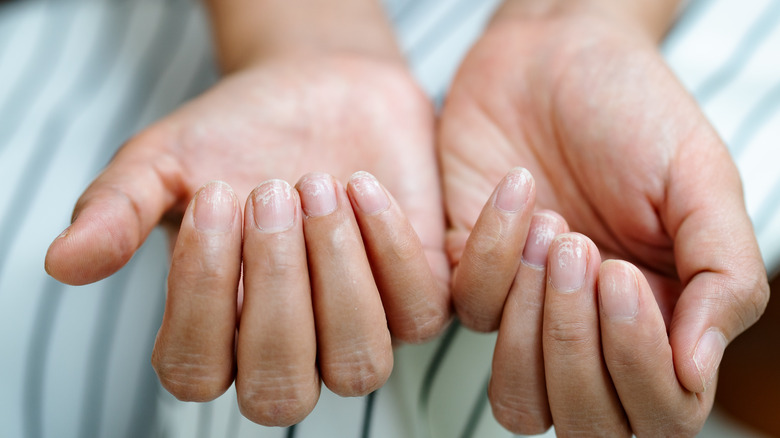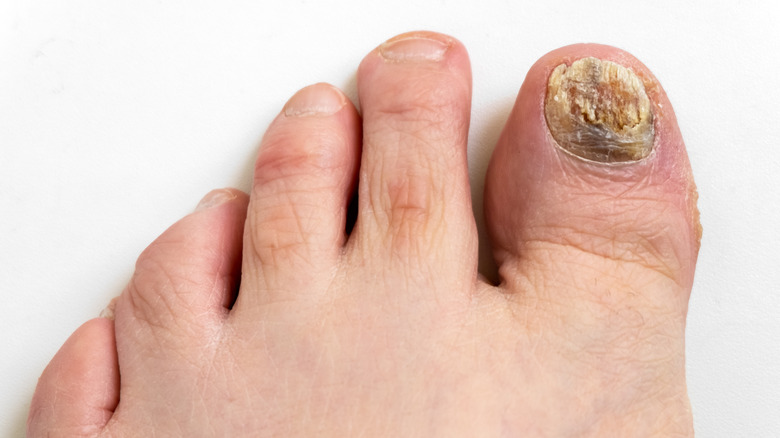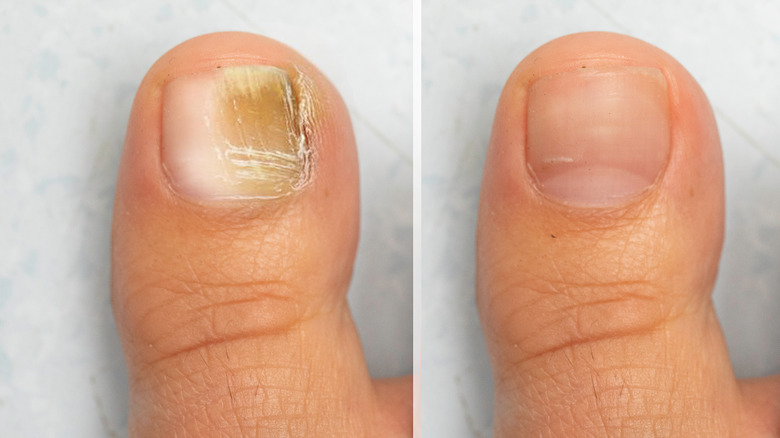Nail Mold Vs. Fungus: What's The Difference And How To Treat Each
If your nails seem funky, you might assume you have nail fungus. According to The Mayo Clinic, the common condition called onychomycosis usually starts as a white or yellow spot under your nail. However, it can grow and discolor your entire nail over time, causing it to flake and crumble while affecting others nearby. The condition, commonly caused by the fungus dermatophyte, can make your nails smell, become thicker, and have a distorted shape. Sometimes you can treat it yourself, but other times you need to see your doctor for treatment, particularly if you have diabetes.
However, not everything that causes nail problems is related to typical nail fungus. Instead, you may have something called nail mold (via Best Review of Zeta Clear). Nail mold occurs when you get water trapped between your nail bed and the surface of an artificial nail or your natural nail. However, mold is actually a fungus. What many people mistakenly call nail mold is actually caused by the Pseudomonas bacteria. It causes a green spot under your nail that can grow, and it looks different from the white or yellow caused by nail fungus. If you've never heard of it, finding out you have mold or bacteria on your digits might be worrisome. Rest assured, though, this condition is treatable. So how can you prevent these nail infections?
Here's how to prevent nail infections
Both nail fungus and mold can happen on your fingers or toes. However, The Mayo Clinic reported that it occurs more commonly in toenails. If you have a severe case of infection, it could permanently damage your nails, which might be embarrassing. However, a terrible condition could also lead to an infection in your foot or beyond, especially if you have a suppressed immune system because of diabetes or medications you might take.
You might have one or more risk factors for developing a nail fungus, including age, heavy sweating, a history of athlete's foot, diabetes, a weakened immune system, walking barefoot in communal areas, minor nail injury, or a condition like psoriasis. If you want to prevent infections, you should keep your nails carefully trimmed using disinfected clippers. Also, hand and foot washing help ward off the issue. You should wear footwear in communal areas and discard or disinfect your old shoes. Changing socks frequently or wearing sweat-absorbing socks can help, too. Finally, you might need to give up artificial nails or polish. If you still find yourself with nail infections, however, treatments are available.
Here's how to treat fungal nail infections
If you have nail fungus or mold, there's good news: You can treat it, and because they're both caused by a fungus, the same treatments can work for both problems. Medical News Today reported that treating these infections can be a long process. You can try over-the-counter remedies like athlete's foot cream and other anti-fungal topical ointments. You can also use oral anti-fungal medications terbinafine (Lamisil), itraconazole (Sporanox), and fluconazole (Diflucan), which require a prescription from your doctor.
The bad news is, the process of treating severe fungal nail infections can take as long as four months for the new nail to grow and replace the old. If you have a horrible problem, your doctor could opt to remove the whole nail. If you've ever had one removed or lost one due to injury, you know the regrowth process takes quite a while. If you've tried and failed to clear up your nail infection on your own, you might need to see your doctor for further treatment options.


